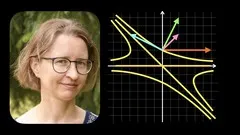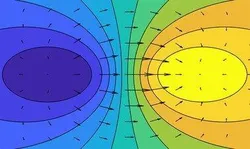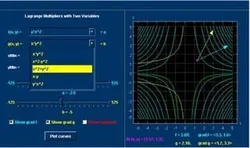
Calculus 3 (multivariable calculus) part 1 of 2 
Calculus 3 (multivariable calculus) part 1 of 2 is a comprehensive course that covers topics such as vector fields, analytical geometry, conic sections, quadric surfaces, topology, coordinates, vector-valued functions, parametric curves, functions of several variables, differentiability, partial derivatives, chain rule, linear approximation, gradient, directional derivatives, implicit functions, Taylor's formula, and optimization. By taking this course, you will gain a deep understanding of these concepts and develop the skills to solve complex problems in multivariable calculus. Get a comprehesive understanding of this course which is a cost course. AZ Class provides this course data for free. Learn more certificate and details here. ▼
ADVERTISEMENT
Course Feature
![]() Cost:
Cost:
Paid
![]() Provider:
Provider:
Udemy
![]() Certificate:
Certificate:
Paid Certification
![]() Language:
Language:
English
![]() Start Date:
Start Date:
2023-10-05
Course Overview
❗The content presented here is sourced directly from Udemy platform. For comprehensive course details, including enrollment information, simply click on the 'Go to class' link on our website.
Updated in [October 18th, 2023]
What does this course tell? (Please note that the following overview content is from the original platform) Calculus 3 (multivariable calculus) part 1 of 2Towards and through the vector fields part 1 of 2(Chapter numbers in Robert A Adams Christopher Essex: Calculus a complete course 8th or 9th edition)C0: Introduction to the course; preliminaries (Chapter 10: very briefly; most of the chapter belongs to prerequisites) S1 About the courseS2 Analytical geometry in R^n (n 2 and n 3): points position vectors lines and planes distance between points (Ch101)S3 Conic sections (circle ellipse parabola hyperbola)S4 Quadric surfaces (spheres cylinders cones ellipsoids paraboloids etc) (Ch105)S5 Topology in R^n: distance open ball neighbourhood open and closed set inner and outer point boundary point (Ch101)S6 Coordinates: Cartesian polar cylindrical spherical coordinates (Ch106)You will learn: to understand which geometrical objects are represented by simpler equations and inequalities in R^2 and R^3 determine whether a set is open or closed if a point is an inner outer or boundary point determine the boundary points describe points and other geometrical objects in the different coordinate systemsC1: Vector-valued functions parametric curves (Chapter 11: 111 113)S7 Introduction to vector-valued functionsS8 Some examples of parametrisationS9 Vector-valued calculus; curve: continuous differentiable and smoothS10 Arc lengthS11 Arc length parametrisationYou will learn: Parametrise some curves (straight lines circles ellipses graphs of functions of one variable);if r(t) (x(t) y(t) z(t)) is a function describing a particle's position in R^3 with respect to time t describe position velocity speed and acceleration; compute arc length of parametric curves arc length parametrisationC2: Functions of several variables; differentiability (Chapter 12) S12 Real-valued functions in multiple variables domain range graph surface level curves level surfacesYou will learn: describe the domain and range of a function Illustrate a function f(xy) with a surface graph or with level curvesS13 Limit continuityYou will learn: calculate limit values determine if a function has limit value or is continuous at one point use common sum- product- rules for limitsS14 Partial derivative tangent plane normal line gradient JacobianYou will learn: calculate first-order partial derivatives compute scalar products (two formulas) and cross pro- duct give formulas for normals and tangent planes; understand functions from R^n to R^m gradients and JacobiansS15 Higher partial derivatesYou will learn: compute higher order partial derivatives use Schwarz' theorem Solve and verify some simple PDEsS16 Chain rule: different versionsYou will learn: calculate the chain rule using dependency diagrams and matrix multiplicationS17 Linear approximation linearisation differentiability differentialYou will learn: determine if a function is differentiable in a point linearisation of a real-valued function use linearisation to derive an approximate value of a function use the test for differentiability (continuous partial derivatives) and properties of differentiable functionsS18 Gradient directional derivativesYou will learn: calculate the gradient find the direction derivative in a certain direction properties of gradients understand the geometric interpretation of the directional derivative give a formula for the tangent and normal lines to a level curveS19 Implicit functionsYou will learn: calculate the Jacobian determinant derive partial derivatives with dependent and free variables of implicit functionsS20 Taylors formula Taylors polynomialYou will learn: derive Taylors polynomials and Taylors formula Understand quadratic forms and learn how to determine if they are positive definite negative definite or indefiniteC3: Optimisation of functions of several variables (Chapter 13: 131:3)S21 Optimisation on open domains (critical points)S22 Optimisation on compact domainsS23 Lagrange multipliers (optimisation with constraints)You will learn: classify critical points: local max and min saddle points; find max and min values for a given function and region; use Lagrange multipliers with one or more conditionsMake sure that you check with your professor what parts of the course you will need for your midterms Such things vary from country to country from university to university and they can even vary from year to year at the same universityA detailed description of the content of the course with all the 255 videos and their titles and with the texts of all the 216 problems solved during this course is presented in the resource file "001 Outline_Calculus3pdf" under video 1 ("Introduction to the course") This content is also presented in video 1 We considered the value of this course from many aspects, and finally summarized it for you from two aspects: skills and knowledge, and the people who benefit from it: (Please note that our content is optimized through artificial intelligence tools and carefully reviewed by our editorial staff.) What skills and knowledge will you acquire during this course? Geometrical Understanding: Understand the geometrical objects represented by equations and inequalities in R^2 and R^3. Determine if a point is an inner, outer, or boundary point of a set. Coordinate Systems: Describe points and other objects in various coordinate systems, including Cartesian, polar, cylindrical, and spherical coordinates. Parametric Curves: Learn about vector-valued functions and parametric curves. Calculate arc length and understand arc length parametrization. Functions of Several Variables: Understand real-valued functions in multiple variables, domain, range, graph, surface, level curves, and level surfaces. Differentiability: Calculate limits, continuity, partial derivatives, tangent planes, normal lines, gradients, and Jacobians. Use the chain rule and Schwarz's theorem. Linear Approximation: Learn about linear approximation, linearization, differentiability, and the properties of differentiable functions. Gradient and Directional Derivatives: Calculate gradients, directional derivatives, and understand their geometric interpretations. Implicit Functions: Compute Jacobian determinants and partial derivatives with dependent and free variables of implicit functions. Taylor's Formula: Derive Taylor's polynomials and understand quadratic forms. Optimization: Optimize functions of several variables on open and compact domains. Use Lagrange multipliers for constrained optimization. Who will benefit from this course? This course on Calculus 3 (multivariable calculus) will benefit individuals who are interested in or pursuing careers in fields such as: 1. Mathematics: This course is essential for students studying mathematics as it covers advanced topics in calculus, including vector-valued functions, parametric curves, functions of several variables, differentiability, and optimization. It provides a solid foundation for further studies in advanced mathematics. 2. Physics: Calculus 3 is highly relevant to physics, particularly in understanding the motion of particles in three-dimensional space. The concepts of position, velocity, speed, and acceleration of particles are covered in this course, which are crucial for physics students. 3. Engineering: Engineers often encounter problems that require the use of multivariable calculus. This course will be beneficial for engineering students as it covers topics such as vector-valued functions, parametric curves, and optimization, which are applicable in various engineering disciplines. 4. Computer Science: Multivariable calculus is relevant in computer graphics, computer vision, and machine learning. Understanding concepts such as gradients, tangent planes, and optimization techniques will be valuable for computer science students interested in these areas. 5. Economics and Finance: Optimization techniques covered in this course, such as Lagrange multipliers, are applicable in economics and finance. Students in these fields can benefit from learning how to find maximum and minimum values of functions with constraints. 6. Architecture and Design: Calculus 3 is useful for architects and designers who need to work with three-dimensional spaces. Concepts such as conic sections, quadric surfaces, and coordinate systems will be relevant in their field. 7. Applied Sciences: Various applied sciences, such as biology, chemistry, and environmental science, require the use of multivariable calculus. Understanding concepts like partial derivatives and gradients can help in analyzing complex systems and phenomena. Overall, this course on Calculus 3 will benefit individuals pursuing careers or interests in mathematics, physics, engineering, computer science, economics, finance, architecture, design, and applied sciences.
Course Syllabus
About the course
Analytical geometry in the space
Conic sections: circle, ellipse, parabola, hyperbola
Quadric surfaces: spheres, cylinders, cones, ellipsoids, paraboloids etc
Topology in R^n
Coordinate systems
Vector-valued functions, introduction
Some examples of parametrisation
Vector-valued calculus; curve: continuous, differentiable, and smooth
Arc length
Arc length parametrisation
Real-valued functions of multiple variables
Limit, continuity
Partial derivative, tangent plane, normal line, gradient, Jacobian
Higher partial derivatives
Chain rule: different variants
Linear approximation, linearisation, differentiability, differential
Gradient, directional derivatives
Implicit functions
Taylor's formula, Taylor's polynomial, quadratic forms
Optimization on open domains (critical points)
Optimization on compact domains
Lagrange multipliers (optimization with constraints)
Final words
Extras
Course Provider

Provider Udemy's Stats at AZClass
Discussion and Reviews
0.0 (Based on 0 reviews)
Explore Similar Online Courses

Business Calculus Made Simple: An Online Course

Become a Calculus 3 Master

Python for Informatics: Exploring Information

Social Network Analysis

Introduction to Systematic Review and Meta-Analysis

The Analytics Edge

DCO042 - Python For Informatics

Causal Diagrams: Draw Your Assumptions Before Your Conclusions

Whole genome sequencing of bacterial genomes - tools and applications

Multivariable Calculus 1: Vectors and Derivatives

Multivariable Calculus (Fall 2007)


Start your review of Calculus 3 (multivariable calculus) part 1 of 2